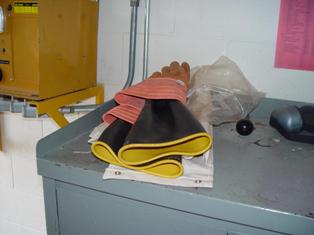Condition monitoring and testing of protective equipment
Control over the state of protective equipment is carried out through their tests, checks and inspections. All protective equipment is subject to established tests after its manufacture, as well as during acceptance into service and periodically during operation.
Testing of protective equipment
Since the main property of most protective means is their insulating ability, then in order to check, a test is conducted by applying a test voltage with power frequency to the insulating part. The magnitude of this voltage is greater than the normal operating voltage and is set in accordance with «Rules for the use and testing of protective equipment used in electrical installations»... The frequency of testing protective equipment in operation is also determined by these rules. Norms and conditions for testing protective equipment are given in the same place.
Protective equipment that can withstand any mechanical load during operation (rods, insulating supports, safety belts and safety ropes, etc.) is also tested for mechanical strength through the load established by the Rules for the use and testing of protective equipment , used in electrical installations.
If any defect, malfunction or damage is found in the process of using a protective device, the protective device is immediately withdrawn from use and sent for repair and elimination of the malfunction, after which an emergency test is carried out.
Protective equipment that has not passed the tests according to the standards is rejected or destroyed or sent for repair, after which it must be tested again.
For accounting purposes, all protective devices in operation are numbered separately for each type. In other words, rods are numbered in order, voltage indicators are numbered, gloves are numbered, etc.
The number of the protective device is placed in a prominent place, and if the protective device consists of several components (boom 110 kV and higher), then the number is placed on each part.
All insulating protective equipment issued for operation are registered in the "Register of protective equipment" indicating the number and date of issue. The person who received the protective equipment marks in the logbook.
The suitability of the protective device is marked by a stamp applied to the insulating part near the edge of the handle. The stamp can be embossed, applied with indelible paint or glued.The text of the seal must indicate the number of the protective agent, for what voltage and for what period it is valid, and which laboratory performed the test.
Rubber products are stamped along the edge (on the lapel of a boat, on the side of galoshes, on the cuff of gloves). Tools with insulated handles are not stamped (due to their small size), but the number must be stamped on the metal part or insulation.
If during the test the protective device is rejected, the stamp is crossed out with red paint.
Monitoring the condition of the protective equipment immediately before each use is mandatory. For this purpose, an external inspection checks the integrity of the parts of the working part, the absence of external damage that could impair the protective effect (cracks, scratches of the varnish coating), the absence of contamination, the presence of a test seal, the suitability of the protective means for use in this electrical installation (by voltage) and the expiration date (by stamp). The use of a protective agent with an expired expiration date is strictly prohibited. It should be decommissioned.
The use of insulating protective means in electrical installations with a voltage higher than that for which the protective equipment is tested is not allowed.
Dielectric gloves are checked by external inspection for cuts, cracks, bubbles, dirt and the like. In addition, the integrity of the glove is checked by rolling it, starting from the bell to the fingers and compressing the air in it. You can hear air leaking through the holes.
Dielectric caps and boots, as well as insulating caps, are inspected for cuts, punctures, or other damage.
For portable grounding, it is necessary to check the wires, clamps, number availability. If portable grounding has been exposed to short-circuit current, it should be checked especially carefully.
Portable grounding, in which the integrity of the conductors is violated (melting, breakage of more than 10% of the conductors), damage to the contact connections of conductors with clamps or the clamps themselves, must be removed from operation.
On the seat belt, they check the integrity of the metal rings (no cracks, the strength of the attachment to the belt), the chain or nylon rope, the carabiner (the correct operation of the buckle) and the belt buckles of the belt.
Before using the measuring pliers, check the integrity of the device, the free movement of the arrow and its correct position at zero separation, the integrity of the connecting wires (with a remote device) and the reliability of their contact with the pliers, the correct operation of the tick mechanism (no jamming, loose connection of the magnetic circuit joint). The surface of the joint should be wiped with a soft cloth.

Condition monitoring and testing of protective equipment
